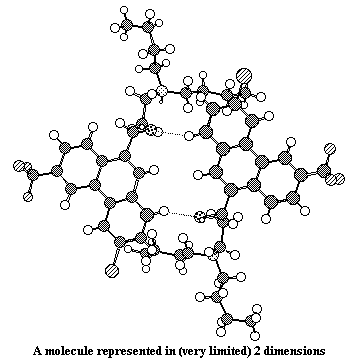CLIC: An Electronic Chemistry Journal
Chemistry is one of the most visual and "three dimensional" of sciences. For many generations, communication of the subject has been rooted on the printed pages of chemical journals, with even colour a rare event. Partially because of such limitations, the subject has evolved a complex and arcane symbolism for its written representation. The complexities of this "chemical nomenclature" in turn result in substantial risk of the propagation of errors and misinterpretation of results. A refereeing system exists to catch both errors of science and transcription errors, but the reality is that referees have few "tools" to assist them to catch errors on the printed page other than then own eyes and minds!
To illustrate how important this can be, consider the antimalerial drug halofantrin. It can have two so called chiral forms,  known as R and S. This molecule also has a very unusual way of interacting with itself ("self-associating") that directly impinges on the method used to separate these two forms (using a process known as chiral separation chromatography). The difference between the R and S forms and how they can be chromatographically separated can only be understood if the chemical structure of the molecule is considered in three dimensions. It takes a highly experienced and confident chemist to translate the diagram shown here, together with the R/S symbolic notation, into the laboratory synthesis of a safe pharmaceutical product. On the printed page, all that can be shown is a two dimensional image taken from one particular perspective view of this molecule. However, in this view, the user cannot rotate or inspect the molecule themselves, and obscured aspects will be hidden.
known as R and S. This molecule also has a very unusual way of interacting with itself ("self-associating") that directly impinges on the method used to separate these two forms (using a process known as chiral separation chromatography). The difference between the R and S forms and how they can be chromatographically separated can only be understood if the chemical structure of the molecule is considered in three dimensions. It takes a highly experienced and confident chemist to translate the diagram shown here, together with the R/S symbolic notation, into the laboratory synthesis of a safe pharmaceutical product. On the printed page, all that can be shown is a two dimensional image taken from one particular perspective view of this molecule. However, in this view, the user cannot rotate or inspect the molecule themselves, and obscured aspects will be hidden.
Modern chemistry is often concerned with systems which might be one hundred times larger and more complex, and the reader may also wish to acquire say detailed toxicology or synthesis data, spectral and instrumental information, accurate three dimensional coordinates for the molecule determined from x-ray crystallography, the structures of a few dozen analogues, details of any enzymes involved in metabolic pathways, mathematical algorithms that describe the molecular properties, and theoretical models which might describe the mechanisms of its behaviour. Most importantly, the reader will also wish to acquire all this information without any risk of transcription errors, in an instantly usable form for further processing by computer.
The CLIC consortium comprises groups in three university chemistry departments (Imperial College, Leeds and Cambridge Universities) and a learned society (The Royal Society of Chemistry) whose basic aim is to create an electronic chemistry journal ("Chemical Commuinications") that will provide such information to the reader, with what might be called "semantic integrity" and accuracy of the information. We even envisage providing mechanisms for readers to comment on the individual articles, and thus to interact with the original authors. To this extent, this aim differs from some other electronic journals, where the paramount objective is to achieve what is called "page integrity" with the original printed version. Whilst semantic and page integrity are not necessarily exclusive, to achieve both requires significant extra effort in storing the basic content of the journal, and its presentation to the user. Thus the CLIC project will concentrate on developing standards for storing, transmitting, displaying and applying molecular information. Not the least task is educating the audience to actively participate in this method of information retrieval, and indeed persuading authors to contribute information in the appropriate form in the first place.
The CLIC Journal and ECTOC Conference Projects
The production of a journal containing features such as the ones illustrated above is already under way. In order to find out whether a general chemistry audience was receptive to such themes, we also carried out a smaller scale pilot project known as the ECTOC conference. The comments received from the "virtual" delegates were highly positive and indeed the planning for the second ECTOC conference is already well under way. The reception given to these conferences has encouraged us to believe we are indeed heading towards a new form of research tool in which collaboration and information come together in a single integrated environment for the benefit of the scientist.
